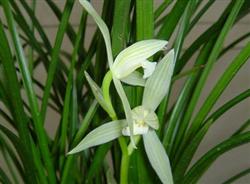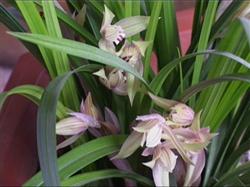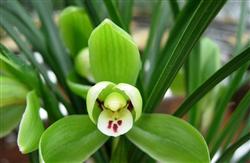Orchid pest control

1. The orchid beetle, commonly known as blue lice, is one of the most common and common pests in bluegrass. This ostracod is covered with a brown flat round wax shell with a diameter of about 0.1 cm, shaped like a flea, and adsorbs on both sides of the leaf or inside and outside the leaf sheath. The worm uses filamentous mouthparts to suck the liquid in the leaves. After scraping off the insect body, there are light yellow marks on the leaf surface, such as the density of the group is high, the injured part becomes yellow gradually, the growth potential is weak, and the serious ones atrophy and die day by day. The simple law of prevention and treatment can be gently deleted longitudinally with a brown brush or a softer toothbrush along the leaf tendons (such as excessive force, brush marks on the leaves, or even broken leaves). The insect body can also be gently scraped off with your fingernails. Or use cotton wool dipped in nicotine sulfate diluent, or stone sulfur mixture, wipe the leaves. However, several pieces of tissue in the center of the leaf bundle are relatively tender, and when wiping, the two fingers of one hand hold the base moderately, while the two fingers of the other hand hold the cotton stained with liquid medicine on both sides of the leaf and wipe it up, so it must be operated carefully, otherwise, the heart leaf is often pulled out or broken. In addition to the above-mentioned liquid killing, strengthen the daily orchid place ventilation and light transmission, to avoid the surrounding environment too wet. 2. Ant orchid root is fleshy root, accumulating a certain amount of water, slightly sweet, and the surrounding soil is very sparse, so ants are often attracted to build nests in basin mud, making the soil loose and affecting root absorption. In accordance with the law of prevention and treatment in ancient China, the orchid was raised in a shallow bowl to hold water, and the pedestal of the orchid was put into it (not immersed in the bottom hole) to prevent ants from invading people. If you have found that there is an ant nest in the basin, you should immediately turn the basin to change the soil, or put something sweet and greasy around the basin to lure the ants out and hunt them step by step. You can also soak the orchid basin into the water and let the water seep through the bottom hole to drive out and drown the ants. In addition, you can sprinkle some DDT powder on the rack to prevent ants from invading the orchid basin. 3. The place where mosquitoes and flies raise orchids is relatively damp, and it is easy to breed mosquitoes and flies, which not only hinders the safe operation of the staff, but also pollutes the leaves, which is very indecent. But also because mosquitoes and flies are easy to bring a variety of germs, causing infections and other diseases. The prevention and treatment method removes the surrounding weeds, garbage and other objects, fills up nearby low-lying, stagnant pools, or inverts unnecessary water containers to reduce their breeding sites. Raise swimming fish in a watering tank to keep the water from giving birth to larvae. Drugs are often used to disinfect the surrounding environment. 4. the environment around earthworm orchid is damp and easy to breed earthworms. Especially in the rainy season, earthworms often climb up the orchid platform and creep into the soft basin soil to feed, making the basin mud layer loose and earthworm dung, which not only does not benefit the growth of Langen, but also hinders the appearance. When these conditions are found, fine lead wires or bamboo sticks can be used to pierce into the dung to induce earthworms to be caught or killed one by one. In addition, the orchid basin can be immersed in water for a while and driven out. In order to put an end to this disease, BHC powder is often sprayed around the Lantai column to kill or dispel it. 5. The red spider is small and scarlet, often clustered on the two sides of the leaves, sucking sap or epidermis from the leaves. After the injury, the leaf tissue is rough or mottled, and the mesophyll dries up and dies gradually. Use cotton wool to wet and dilute dimethoate or fish rattan semen and wipe it off step by step. 6. Caterpillars belong to the larvae of butterfly moths with many species. Often lodging in the trees around the orchid, eating leaves, falling by the wind and near the orchid, and then climbing up the orchid, infringing on the orchid leaves, buds and so on. The prevention and treatment method regularly sprays the surrounding trees with insecticide solution, or directly capture it and kill it.
- Prev

Characteristics and cultivation points of Orchid
1. Tidbits orchids have a long history of cultivation in China, with a history of thousands of years. It has been cultivated all over the country, especially in the southwest and Taiwan. It has the reputation of "the first incense in the world" and "fragrant beauty". Orchid blossoms are plain and clean, soft and elegant, fragrant and pleasant, and are unique personified flowers in the world. In ancient times, there was ".
- Next

Control of common diseases in orchids
1. Phytophthora disease: it occurs all the year round, but in the plum rain season, the disease is the most serious when watering is too wet or poor ventilation, especially the seedlings just out of the bottle are the most vulnerable. The infected site produced brown disease spot, which expanded rapidly in high temperature and humidity, and finally showed black brown spot, and deciduous stem rot until the plant died. Prevention and treatment methods:.
Related
- Fuxing push coffee new agricultural production and marketing class: lack of small-scale processing plants
- Jujube rice field leisure farm deep ploughing Yilan for five years to create a space for organic food and play
- Nongyu Farm-A trial of organic papaya for brave women with advanced technology
- Four points for attention in the prevention and control of diseases and insect pests of edible fungi
- How to add nutrient solution to Edible Fungi
- Is there any good way to control edible fungus mites?
- Open Inoculation Technology of Edible Fungi
- Is there any clever way to use fertilizer for edible fungus in winter?
- What agents are used to kill the pathogens of edible fungi in the mushroom shed?
- Rapid drying of Edible Fungi

